In summer, most CMH visitors fly into Calgary (YYC) and start their mountain journey in Banff. This is where our coach buses pick up guests en route to their CMH destination.
However, if you’re self-driving, flying into Kelowna (YLW) is a fantastic alternate option for those who wish to explore something different.
Starting in Kelowna provides flexibility to tack on a few days in the Okanagan Wine Region before driving through B.C.’s most mountainous zones on your way to either CMH Bugaboos Lodge or CMH Bobbie Burns Lodge.
There are some great flight options into Kelowna International Airport (YLW). Travellers flying into Kelowna from Vancouver, Victoria and Seattle, will find direct flights with less total travel time on Air Canada, WestJet or Alaska Airlines.
We love Banff—its where CMH HQ is located and is indeed a spectacular place—but Banff’s summer months do boom in popularity. So for travellers who seek a quieter, less crowded experience, deeper connection to local culture or better last-minute availability on lodging options, here’s more detail on the other approaches that exist via Kelowna.
Route: Kelowna -> Revelstoke -> Golden -> CMH
Start: Kelowna International Airport
End: CMH Bobbie Burns helipad or CMH Bugaboos helipad
Distance: 403 km / 250 mi
Total drive time (non-stop): 4 hr 45 min
Suggested days: 2-4
Map: driving directions
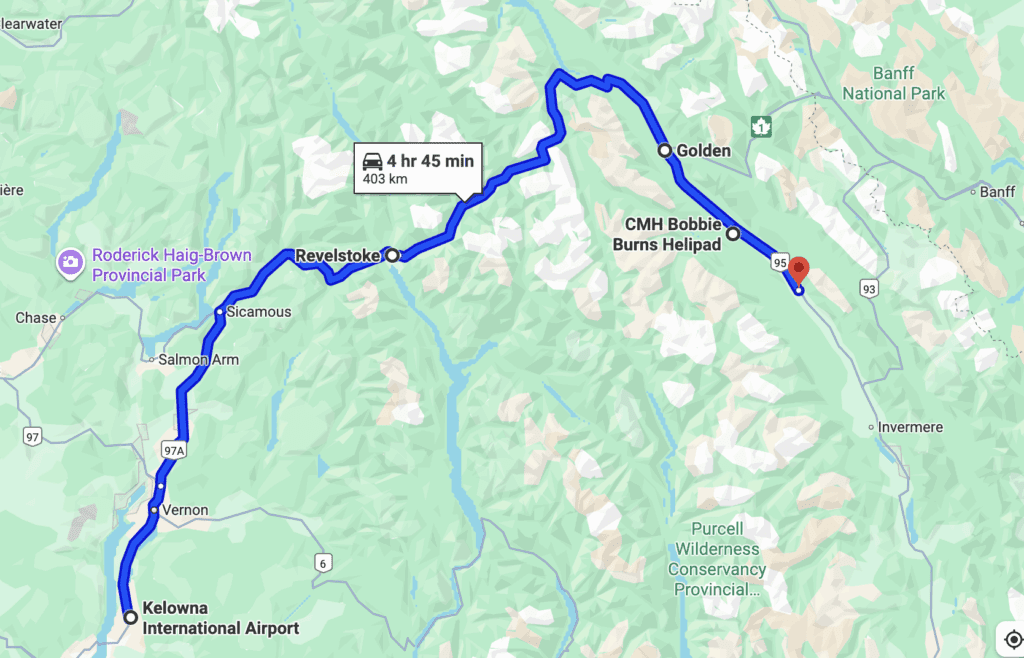
We suggest self-driving through British Columbia’s adventure gateway towns of Revelstoke and Golden. You’ll pass through both towns en route to CMH Bugaboos Lodge or CMH Bobbie Burns Lodge.
This approach is no sacrifice in terrain or topography. The route follows the TransCanada east from Kelowna and traverses memorable mountain terrain, including three iconic national parks and two booming mountain towns overflowing with culture, character and recreation potential.
Once sleepy roadside stopovers, these new recreation boomtowns have added attractions, upscale amenities and even more opportunities for adventure—all without losing the small mountain town character that has long been part of their allure.
Note: The suggestions we’ve included focus on the journey from Kelowna to CMH Bobbie Burns and Bugaboos. However, if you’re travelling to CMH Cariboos Lodge, you can also self-drive from Kelowna via Kamloops and then through the North Thompson River Valley.
Part 1: Kelowna to Revelstoke
Revelstoke is close to our heart since we were the first operation to secure heli-skiing tenure in a region that became the epicentre of the heli-skiing industry. Once a railroad town where mountain guides settled due to its affordability, Revelstoke boomed into one of Canada’s hottest ski towns and real estate markets after the development of Revelstoke Mountain Resort more than a decade-and-a-half ago.
Ski bars, trendy restaurants, homey coffee shops and gear shops populate the living, breathing and very charismatic small-town core while trailheads, outfitters and an endless menu of recreation possibilities make this an adventure tourism hub at the cross-section of four famous mountain ranges.
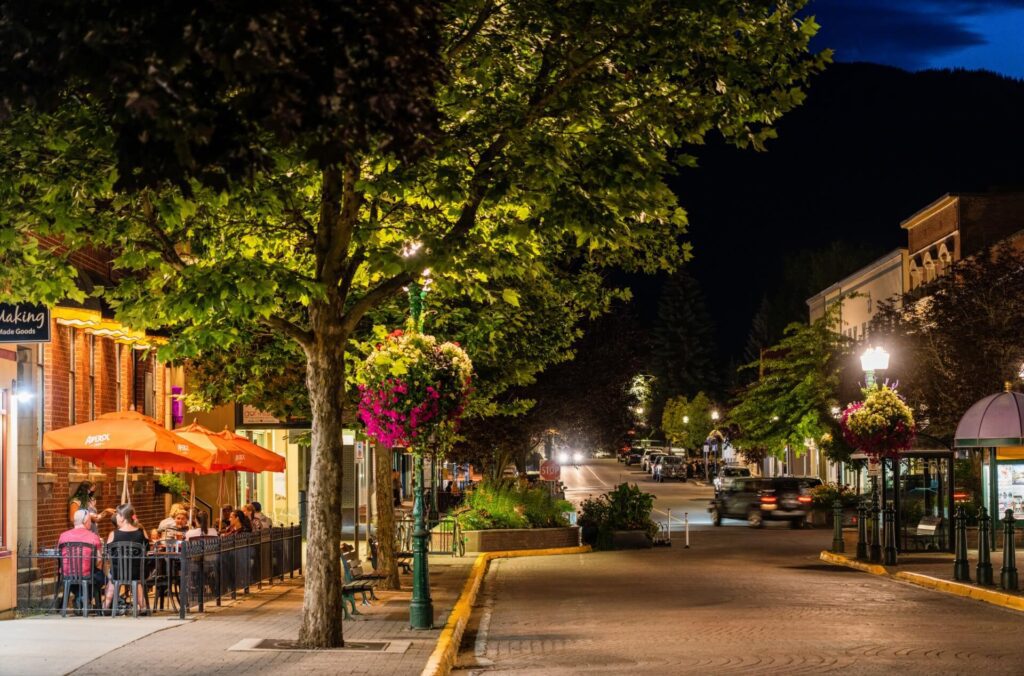
Where to stay in Revelstoke
While the town of Revelstoke is full of lodging options, our top choices are the Regent Hotel for its convenient location in the heart of town, and the Sutton Place Hotel for a combination of luxury and slopeside access at the base of Revelstoke Mountain Resort.
Six kilometres from the downtown grid and much quieter in summer, the mountain base village hosts lift accessed mountain biking, two thrilling mountain coasters (reservations required), a gondola-accessed cliff walk suspension bridge and enough dining options on site to make even a short trip to town seem unnecessary.
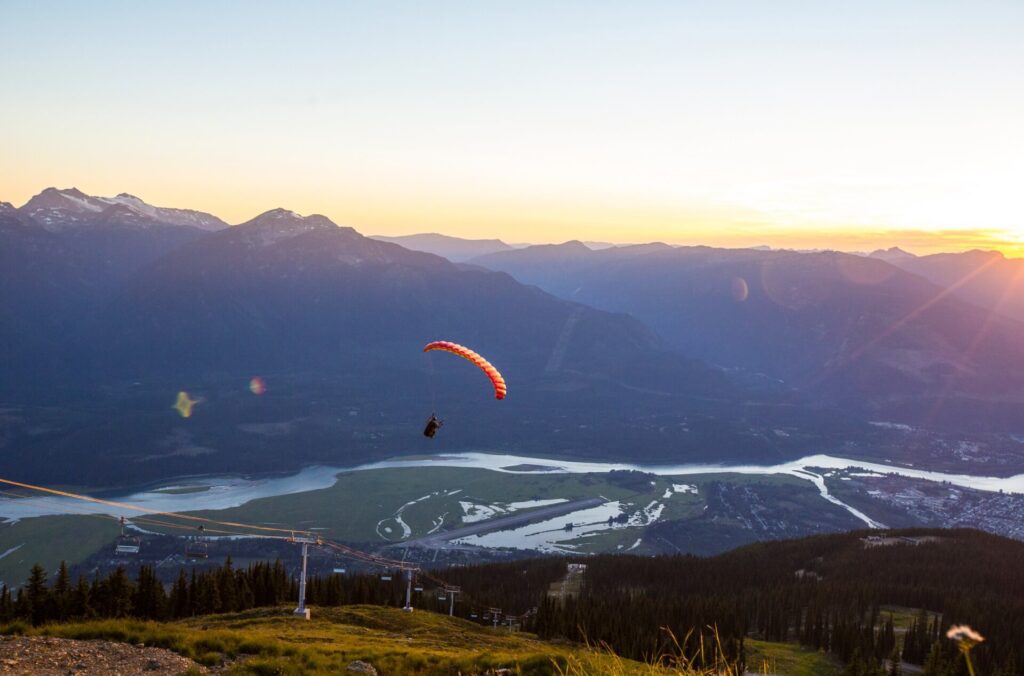
National parks near Revelstoke to explore
While Banff and Jasper are exponentially more famous, Canada’s National Parks on the west side of the continental divide deliver towering peaks, longstanding heritage and endless alpine recreation with a fraction of the summer visitation.
As you drive between Revelstoke to Golden, you’ll pass through two national parks. Each one could deliver a packed weeklong itinerary in itself, but we’ve provided a menu for a self-guided high points tour through these protected national treasures.
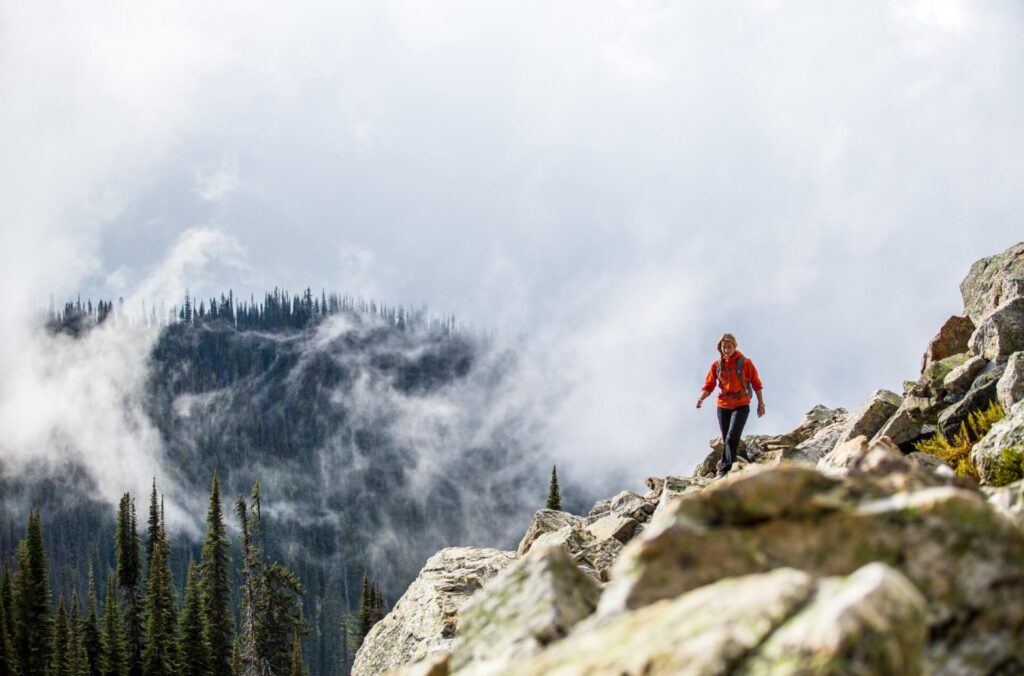
Mt Revelstoke National Park
Many visitors to Canada are surprised that the road access to our wilderness is often rough and rugged. Mt. Revelstoke National Park rises as a dramatic counter-example to the high-clearance stereotype, with what could be the best scenic byway drive in all of British Columbia located just a simple left turn off the TransCanada highway.
At the same time, few Canadian drives offer the stunning, elevated perspective of Mt Revelstoke National Park’s Meadows in the Sky Parkway. Rising from 470 metres of elevation at its junction with the TransCanada to 1,835 metres high at Balsam Lake, this 26-kilometre one-way, switchbacking journey includes numerous vistas, pullouts and trailheads that provide deeper access to the peaks and valleys of the Selkirks.
Our top three stops on this slow, switchbacking climb are the Inspiration Woods Trail, a 2.5 km loop through cedar hemlock rainforest, the Nels Nelson viewpoint, a historic home to a long-gone legendary ski jump, and the Monashee viewpoint, which serves as the trailhead for the Summit Trail, a steep 20 km roundtrip ramble with 1,350 metres of elevation gain.
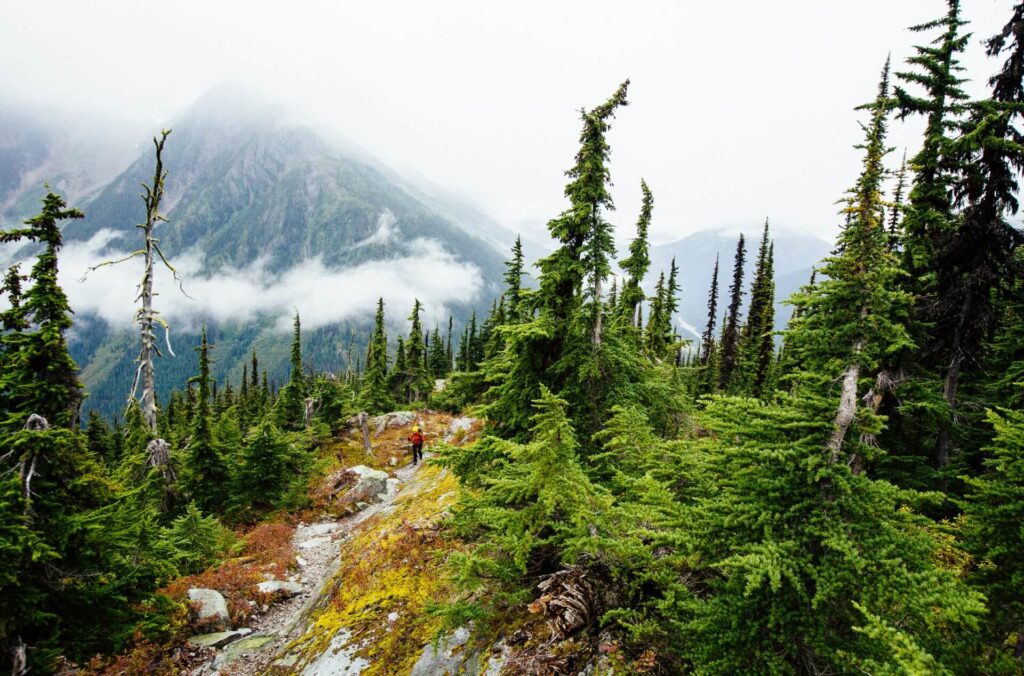
Glacier National Park
Way back when, Rogers Pass was a marquee destination on the Canadian Pacific Railway transcontinental route. With status as the last link in the chain that connected the country, the area surrounding the 1,330-meter pass became Canada’s third national park in 1886. Before long, the magical alpine terrain transitioned to a stop for adventure tourism, with the ornate Glacier House for lodging and the mountaineering guidance of the imported Swiss Guides.
The rail route went underground after 1910 and the Glacier House turned to ruin, but the TransCanada Highway pushed through four decades later, granting world-class roadside backcountry access to that same alpine wonderland for skiers, hikers and climbers. The long-loved hotel of the second wave—The Glacier Park Lodge—is also now only a fond memory, yet the powerful draw of roadside alpine access in Canada’s third national park remains.
Abundant with trailheads, objectives and scenery, the park features both ancient, inland temperate rainforest and 3,000-meter-plus peaks such as Mt Sir Donald, which looms over Rogers Pass. The park is home to the world’s only inland cedar rainforest and many hiking objectives from the strenuous, such as Balu Pass or Glacier Crest, to the short strolls of Loop Brook or the Meeting of the Waters Trail. Either way, the most mandatory stop is at the top of the TransCanada where the Rogers Pass National Historic Site and Rogers Pass Discovery Centre provide more than a few hours of roadside diversion amidst the jaw-dropping backdrops.

Part 2: Revelstoke to Golden
The drier east side cousin to Revelstoke, Golden has become an adventure boomtown in its own right with Kicking Horse Resort, another massive-vertical ski area that centers the town scene. In summer, Kicking Horse offers gondola-accessed hiking, while just outside of town Pursuit’s Golden Skybridge towers 400+ feet above an expansive nearby canyon and provides a chance to link two bridges via a leisurely 3K nature walk.

For those with more taste for adrenaline, the glacially fed Kicking Horse river is a powerful local draw as an iconic whitewater rafting destination. With three runnable sections of its canyon, the raging western river supplies scenic class-three and class-four stretches, with a number of local outfitters running day trips that also include heli rafting options.
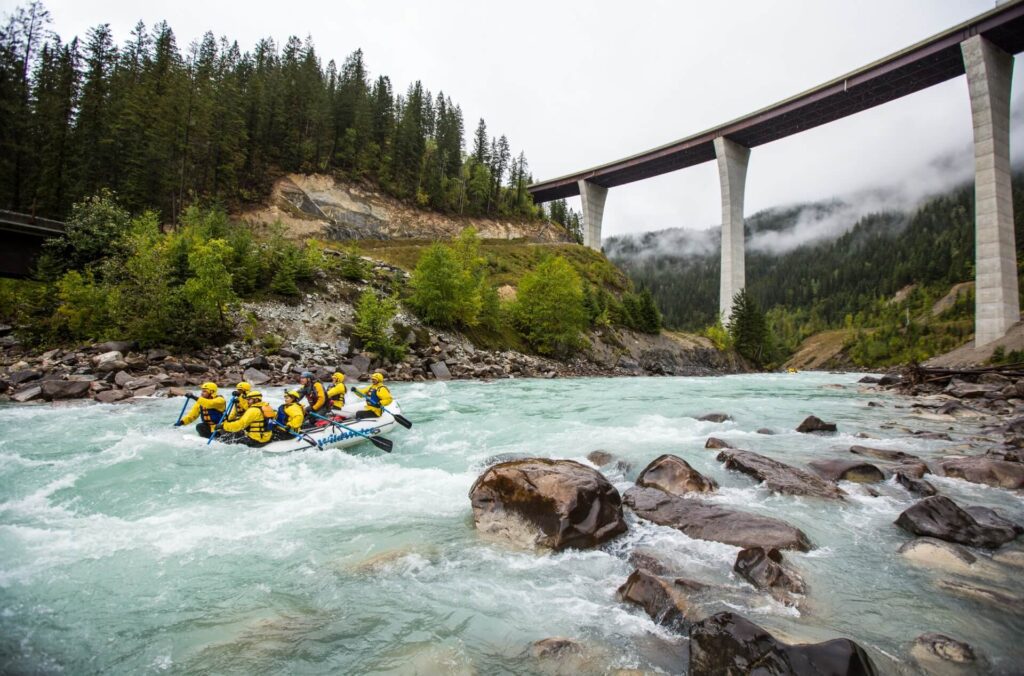
Where to stay in Golden
The history of mountain guiding in Canada traces its roots to the Swiss Guides who were first imported by the Canadian Pacific Railway to take railway travellers into the peaks above Rogers Pass and eventually throughout the region.
With 35 Swiss guides emigrating between 1899 and 1954, these hardened mountain men not only established alpinism, the guiding profession and a national Alpine Club in Canada but also led more than 250 first ascents of peaks in the Selkirks and Rockies. In their entire guiding era, they also had an extraordinary record of zero fatalities.
From these Swiss guides grew the roots of mountain culture in Canada. A second generation of Swiss guides (sometimes called The Swiss Mafia), both descendants of the first generation and a new crew hired to work at Rogers Pass and in Lake Louise, supplied a significant number of the first heli-skiing guides for CMH’s Austrian-born founder Hans Gmoser. That Swiss heritage, connection and immigration pipeline helped established Canada’s mountaineering culture and played a foundational role in Canada’s mountain disciplines for more than a century.
In 1911 the Edelweiss Village was built by the CPR to house the original Swiss Guides and their families in Golden, BC. Meticulously preserved and recently restored, these six historic Swiss-styled chalets are now a hillside retreat for those seeking tranquility, adventure, connection with nature and a feel for a distinctly eclectic Swiss-Canadian flair. Spending even one night on-site in this preserved piece of guiding history is one way for CMH visitors to connect to the historical roots of the Swiss Guides and the foundation of alpinism in Canada.
National Parks near Golden to explore
From Golden, you can venture to nearby Yoho National Park for a day trip. Or, if you plan to continue on to Banff or Calgary, you can drive there from Golden—a route that travels through Yoho National Park.
Yoho National Park
With more than 400 kilometres of hiking trails, towering peaks and hanging glaciers, Yoho National Park delivers in both scope and scale, rivalling even its eastside neighbour, Banff National Park, in spectacular Rocky Mountain vistas. Originally opened to tourism due to the completion of the transcontinental railroad, Canada’s second national park is home to many historic sites important to mountaineering including The Stanley Mitchell Hut and The Elizabeth Parker Hut, two century-old Canadian Alpine Club huts that are deeply tied to the Swiss Guides and the history of Canadian alpinism.
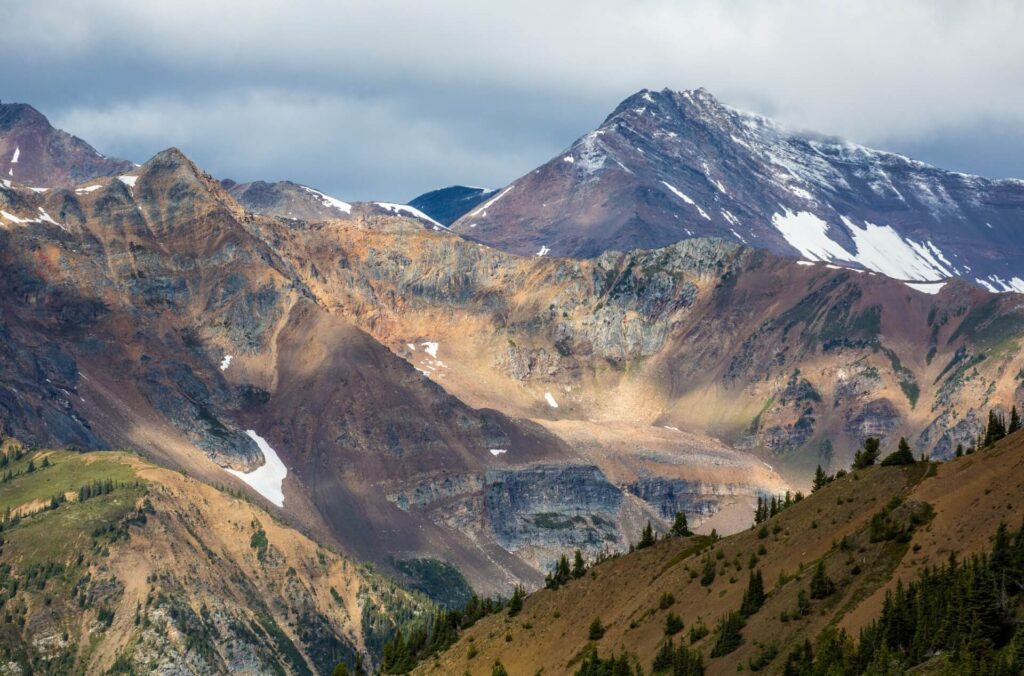
The most convenient roadside stops in Yoho are the spiral tunnels viewpoints that provide perspective on the Herculean task of building a railroad through Canada’s continental divide. The shuttle bus ride into Lake O’Hara (reservations required) is an easy way to experience the surrounding grandeur, while a pleasant 8K one-way day hike to Twin Falls and the Twin Falls Teahouse National Historic evokes that early era of railroad tourism. For those with more fitness and ambition, the 1,500-metre gain, 7-mile round trip to Abbott Pass, a mind-blower and lung-burner, ends at the former site of one of Canadian alpinism’s most storied mountaineering huts.
We can help you plan
Feeling inspired and curious about more ways to combine a CMH heli-hiking trip with other summer adventures? Our vacation planning team has great recommendations, preferred hotel rates, and local knowledge.
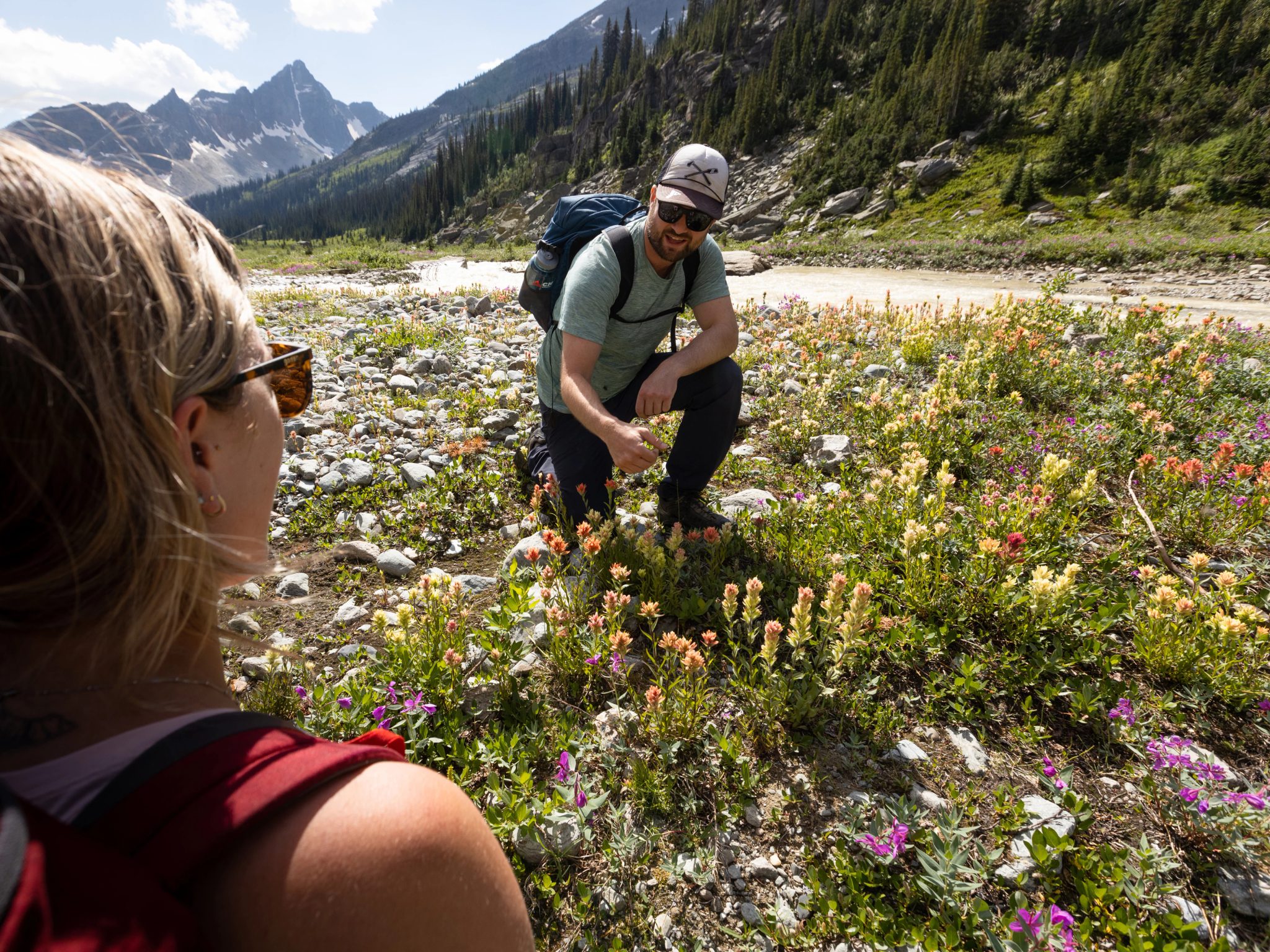
In this story
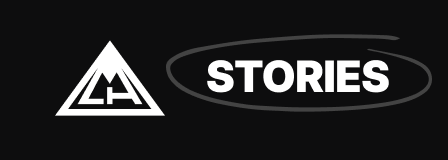
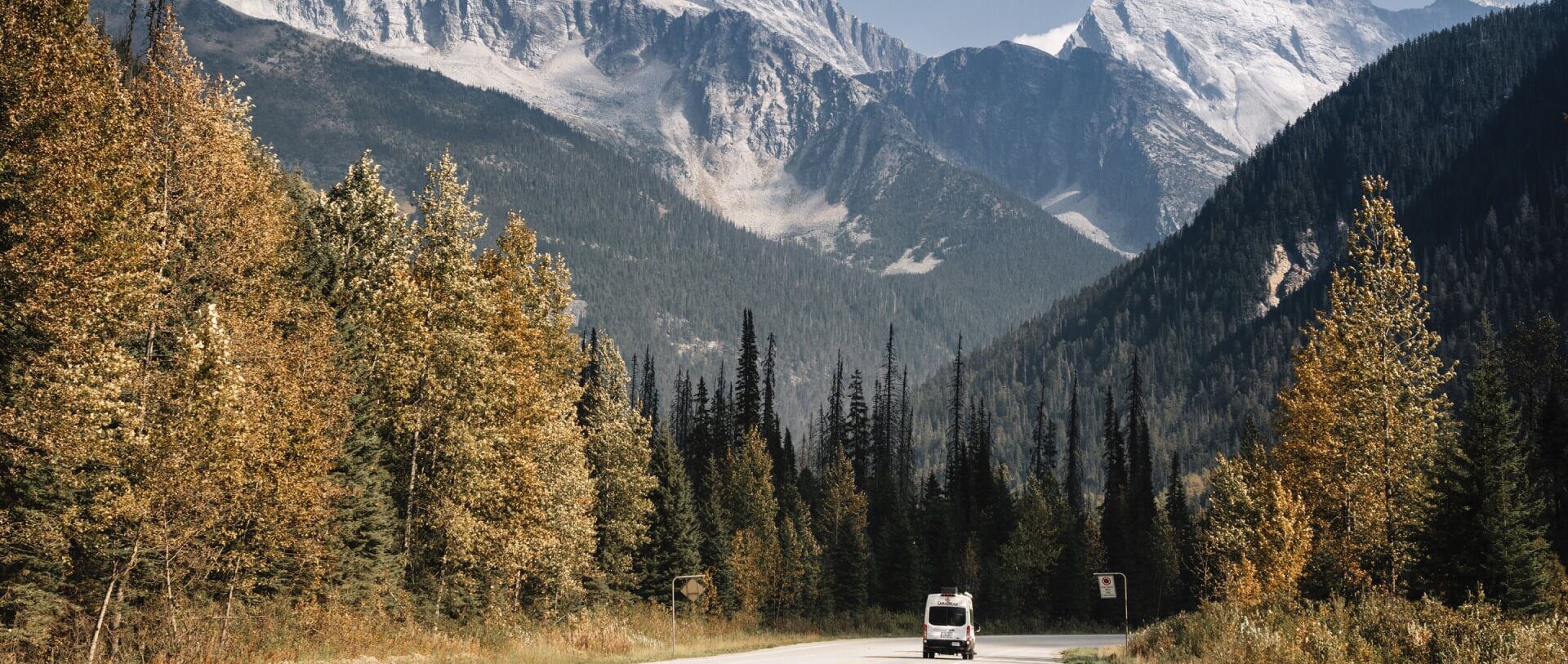
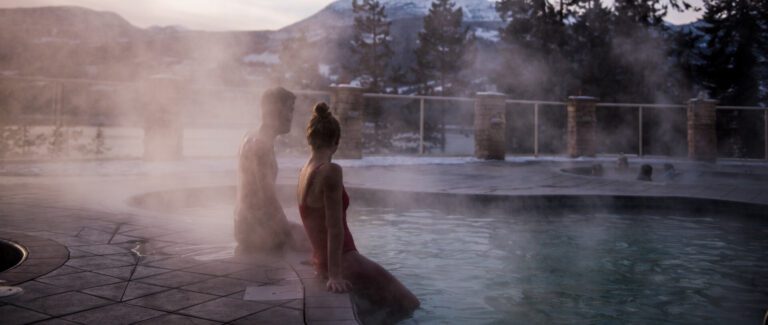
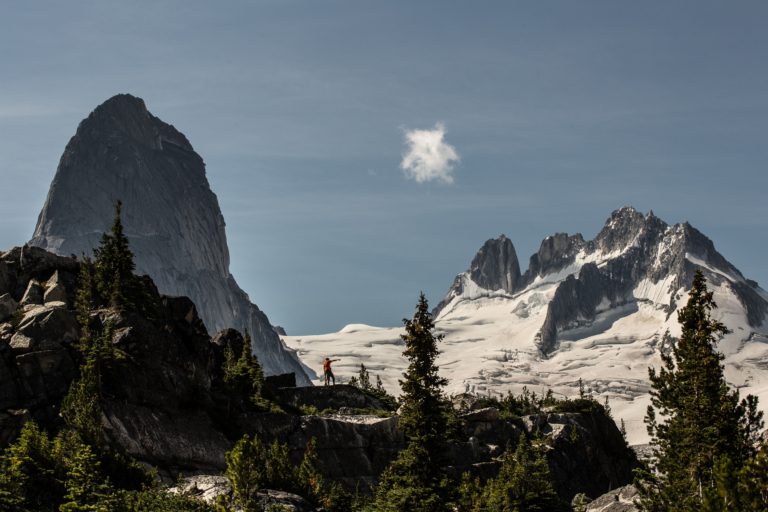
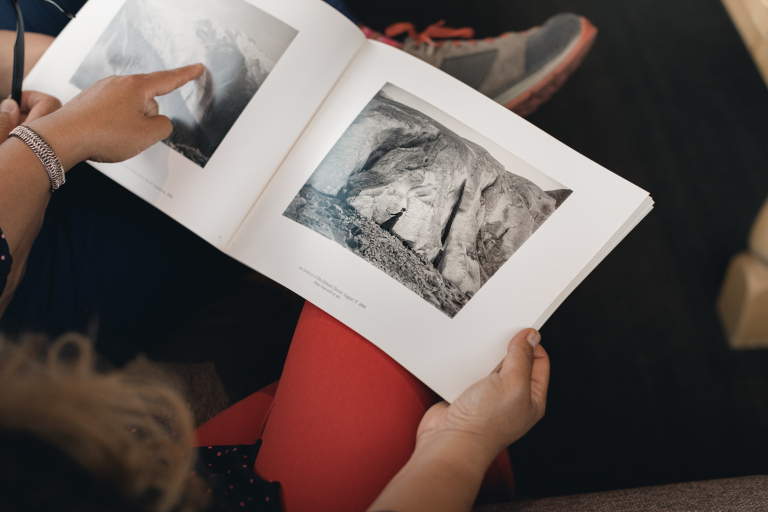
Comments